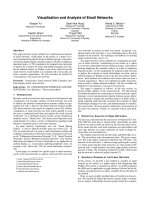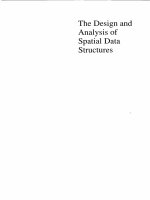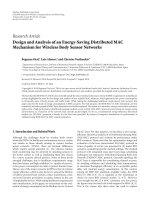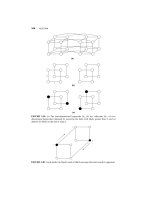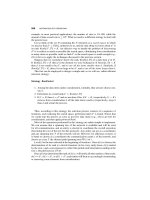stochastic modeling and analysis of telecoms networks
Bạn đang xem bản rút gọn của tài liệu. Xem và tải ngay bản đầy đủ của tài liệu tại đây (6.47 MB, 385 trang )
Stochastic Modeling and Analysis of Telecom Networks
www.it-ebooks.info
Stochastic Modeling
and Analysis of
Telecom Networks
Laurent Decreusefond
Pascal Moyal
Series Editor
Nikolaos Limnios
www.it-ebooks.info
First published 2012 in Great Britain and the United States by ISTE Ltd and John Wiley & Sons, Inc.
Apart from any fair dealing for the purposes of research or private study, or criticism or review, as
permitted under the Copyright, Designs and Patents Act 1988, this publication may only be reproduced,
stored or transmitted, in any form or by any means, with the prior permission in writing of the publishers,
or in the case of reprographic reproduction in accordance with the terms and licenses issued by the
CLA. Enquiries concerning reproduction outside these terms should be sent to the publishers at the
undermentioned address:
ISTE Ltd John Wiley & Sons, Inc.
27-37 St George’s Road 111 River Street
London SW19 4EU Hoboken, NJ 07030
UK USA
www.iste.co.uk www.wiley.com
© ISTE Ltd 2012
The rights of Laurent Decreusefond and Pascal Moyal to be identified as the authors of this work have
been asserted by them in accordance with the Copyright, Designs and Patents Act 1988.
____________________________________________________________________________________
Library of Congress Cataloging-in-Publication Data
Decreusefond, Laurent, 1966-
Stochastic modeling and analysis of telecom networks / Laurent Decreusefond, Pascal Moyal.
p. cm.
Includes bibliographical references and index.
ISBN 978-1-84821-238-1
1. Mobile communication systems. 2. System analysis Mathematical models. I. Moyal, Pascal, 1978-
II. Title.
TK5103.2.D43 2011
621.3845'6051922 dc23
2011036865
British Library Cataloguing-in-Publication Data
A CIP record for this book is available from the British Library
ISBN: 978-1-84821-238-1
Printed and bound in Great Britain by CPI Group (UK) Ltd., Croydon, Surrey CR0 4YY
www.it-ebooks.info
Table of Contents
Preface ix
Chapter 1. Introduction 1
1.1. Traffic, load, Erlang, etc. 1
1.2. Notations and nomenclature 7
1.3. Lindley and Beneˇs 10
1.4. Notes and comments 18
P
ART 1: DISCRETE-TIME MODELING 21
Chapter 2. Stochastic Recursive Sequences 23
2.1. Canonical space 24
2.2. Loynes’s scheme 30
2.3. Coupling 34
2.4. Comparison of stochastic recursive sequences 40
2.5. Notes and comments 43
Chapter 3. Markov Chains 45
3.1. Definition and examples 45
3.2. Strong Markov property 49
3.3. Classification of states 52
3.4. Invariant measures and invariant probability 60
3.5. Effective calculation of the invariant probability 75
3.6. Problems 77
3.7. Notes and comments 80
Chapter 4. Stationary Queues 83
4.1. Single server queues 84
4.2. Processor sharing queue 104
www.it-ebooks.info
vi Networks Modeling and Analysis
4.3. Parallel queues 106
4.4. The queue with S servers 117
4.5. Infinite servers queue 124
4.6. Queues with impatient customers 127
4.7. Notes and comments 146
Chapter 5. The M/GI/1 Queue 149
5.1. The number of customers in the queue 149
5.2. Pollacek-Khinchin formulas 153
5.3. Sojourn time 156
5.4. Tail distribution of the waiting time 158
5.5. Busy periods 160
P
ART 2: CONTINUOUS-TIME MODELING 167
Chapter 6. Poisson Process 169
6.1. Definitions 170
6.2. Properties 176
6.3. Discrete analog: the Bernoulli process 181
6.4. Simulation of the Poisson process 183
6.5. Non-homogeneous Poisson process 185
6.6. Cox processes 189
6.7. Problems 189
6.8. Notes and comments 191
Chapter 7. Markov Process 193
7.1. Preliminaries 193
7.2. Pathwise construction 195
7.3. Markovian semi-group and infinitesimal generator 199
7.4. Martingale problem 215
7.5. Reversibility and applications 220
7.6. Markov Modulated Poisson Processes 226
7.7. Problems 232
7.8. Notes and comments 234
Chapter 8. Systems with Delay 237
8.1. Little’s formula 237
8.2. Single server queue 241
8.3. Multiple server queue 245
8.4. Processor sharing queue 252
8.5. The M/M/∞ queue 253
8.6. The departure process 254
www.it-ebooks.info
Table of Contents vii
8.7. Queuing networks 255
8.8. Problems 265
8.9. Notes and comments 268
Chapter 9. Loss Systems 271
9.1. General 271
9.2. Erlang model 274
9.3. The M/M/1/1 + C queue 276
9.4. The “trunk” effect 279
9.5. Engset model 280
9.6. IPP/M/S/S queue 281
9.7. Generalized Erlang models 285
9.8. Hierarchical networks 289
9.9. A model with balking 294
9.10. A call center with impatient customers 301
9.11. Problems 303
9.12. Notes and comments 304
P
ART 3: SPATIAL MODELING 307
Chapter 10. Spatial Point Processes 309
10.1. Preliminary 309
10.2. Stochastic geometry 310
10.3. Poisson process 311
10.4. Stochastic analysis 326
10.5. Problems 336
10.6. Notes and comments 337
Appendix A. Mathematical Toolbox 339
A.1. Probability spaces and processes 339
A.2. Conditional expectation 347
A.3. Vector spaces and orders 352
A.4. Bounded variation processes 356
A.5. Martingales 363
A.6. Laplace transform 378
A.7. Notes and comments 379
Bibliography 381
Index 385
www.it-ebooks.info
1
Preface
In mobile telecommunications, ARCEP (the French Regulatory Authority for
Electronic Communicationsand Postalservices) publishesan annualanalysis ofquality
of different mobile radio networks. For voice, the two criteria are the ability to start
up a communication and to hold it for 2 or 5 minutes as well as the audio quality
of the communication. For each data service, the transmission time and integrity of
the message (SMS, MMS) are tested in different situations: urban, semi-urban, for
pedestrians, cars, high-speed train, etc.
The results of these tests are often used as commercial arguments. On the contrary,
bad results may rapidly alter the image of a telecom operator in the public opinion
and thus lead to an economic disaster. Hence, these performance tests are a major
challenge for the whole telecom industry. The satisfaction of some of these criteria
depends directly on the number of resources allocated to the network, including the
capacity of the so-called base stations. The operator must have some quantitative means
to anticipate demand and its impact on the design of its network. If we want to move
beyond the phase of divination, then modelization is needed. This is about putting
into equations, although sometimes with a kabbalistic aspect, the phenomenon which
we want to study. To each situation may correspond several models depending on
whether one is interested in the microscopic or macroscopic scale, the long or short
time behavior, and so on. Ideally, the choice should be made only based on purpose
but it is also conditioned by the technical and mathematical knowledge of the people
who build the model.
Once the problem is raised, it must be solved: in other words, if numbers are given
in input, then some numbers should pop up in output. Thanks to advances in computing,
the situation has changed dramatically in the last twenty years. It is now possible to
calculate quantities that are not only defined by explicit mathematical formulas, but
that may result from more or less sophisticated algorithms.
www.it-ebooks.info
x Networks Modeling and Analysis
A model is also often a support for simulation, in this way it creates an artificial
simplification of reality. If this method gives very often only approximate results and
is costly in computation time, it is also often the only possible.
We tried in this book to show for what purpose could stochastic models be used in
telecommunications networks, with quantitative as well as qualitive points of view. We
wanted to vary the possible approaches (discrete time, continuous time Markov chains
or processes, recurrent sequences, spatial modeling) to allow the reader to proceed with
his modelization works himself. We have not, far from it, addressed all themes and all
the technicalities on which the researchers are currently working. In particular, we did
not discuss fluid limits and Palm measures, but we hope that our readers can take the
rich literature to extend their thinking. We have tried to be as complete as possible in
the mathematical prerequisites. Proofs and results that are missing can be found easily
in many books that appear in the references. To emphasize the computational aspects
and to help our student readers, we have very often explained the algorithms that to be
implemented in order to solve a particular problem. Languages such as Octave, Scilab
or Scipy/Numpy (available through the SAGE platform) are particularly well suited
to the vector computations that appear here and allow us to instantiate the algorithms
described in a few lines only.
This book would not exist without the assistance of a considerable number of
people. The first draft of this book is a handout from Telecom ParisTech written by
L. Decreusefond, D. Kofman, H. Korezlioglu and S. Tohme. The introduction to the
martingale theory owes much to a handout from A.S. Üstünel. We have tried as much
as possible to present the underlying network protocols. It must be noted that the
decryption of standards of thousands of pages and their translation into human language
require much work and fine knowledge in a wide variety of disciplines, and as well as
infinite patience. We wish to thank C. Rigault and especially P. Martins, without whom
we would not know what POTS was and even less OFDMA.
We heartily thank N.Limnios, who offered us a beginning on this long-term venture,
as well as our colleagues C. Graham, Ph. Robert and F. Baccelli, with whom we have
had much interaction on these topics for several years. This book would not have been
what it is without the inspiration born from reading their books on these topics.
A big thanks to our partners for having supported us at difficult times. Thanks to
Adele for her help.
Our students or colleagues, E. Ferraz, I. Flint, P. Martins, A. Vergne, T. T. Vu have
reviewed and amended all or part of this opus. We thank them for participating in an
often thankless task. The residual errors are ours.
Paris, February 2012.
www.it-ebooks.info
Chapter 1
Introduction
1.1. Traffic, load, Erlang, etc.
In electricity, we count the amps or volts; in meteorology, we measure the pressure;
in telecommunications, we count the Erlangs.
The telephone came into existence in 1870. Most of the concepts and notations
were derived during this period. Looking at a telephone connection over a time period
of length T, we define its observed traffic flow as the percentage of time during which
the connection is busy
ρ =
i
t
i
T
.
A priori, traffic is a dimensionless quantity since it is the ratio of the occupation time
to the total time. However, it still has a unit, Erlang, in remembrance of Erlang who,
along with Palm, was one of the pioneers of the performance assessment of telephone
networks. Therefore, a load of 1 Erlang corresponds to an always busy connection.
Time
0
T
t
1
t
2
t
3
t
4
Figure 1.1. Traffic of a connection: ratio of the occupation time to the total time of observation
Stochastic Modeling and Analysis of Telecom Networks Laurent Decreusefond and Pascal Moyal
© 2012 ISTE Ltd. Published 2012 by ISTE Ltd.
www.it-ebooks.info
2 Networks Modeling and Analysis
Looking at several connections, the traffic carried by this trunk is the sum of the
traffic of each connection
ρ
trunk
=
connections
ρ
connection
.
This is no longer a percentage, but we can give a physical interpretation to this quantity
according to the ergodic hypothesis. In fact, assume that the number of junctions is
large, then we can calculate the average occupation rate in two different ways: either by
calculating the percentage of the occupation time of a particular connection over a large
period of time; or by computing the percentage of busy connections at a given time.
In statistical physics, the ergodicity of a set of gas molecules implies that the spatial
averages (for example, averages calculated on the set of gas molecules) are equal to
time averages (i.e. averages calculated over a molecule for a long period of time). By
analogy, we now assume that the same holds true for the occupation rate of telephone
connections. We, therefore, have
p = lim
T →∞
1
T
j
t
j
= lim
N→∞
1
N
n
X
n
(t), [1.1]
where X
n
=1if the junction n is busy at time t, X
n
=0,otherwise. Note that on the
right-hand side, the value of t is arbitrary. This implies that we have implicitly assumed
that the system is in steady state, that is statistically, its behavior does not change with
time. When the number of junctions is large, it is unrealistic to try to define a structure
of correlation between them. It is therefore reasonable to assume that a connection is
free or busy, irrespective of the situation of other connections. Therefore, at a given
time t, the number of busy connections follows a binomial distribution with parameters
N (the total number of connections) and p (calculated by equation [1.1]). The average
number of busy connections is Np at each moment.
This relation provides a simple and efficient way to estimate p. Telephone switches
have among other functions to count the number of ongoing calls at each moment. By
averaging this number over 15 seconds, we obtain a fairly accurate estimation of the
average number of simultaneous calls, that is an estimation of p.
This raises a question: How to choose T and when to carry out the measurements?
It is in fact clear that the traffic fluctuates throughout the day based on the human
activities. For we want to reduce and ensure a low failure rates, it is necessary to
consider the worst case and conduct measurements during heavy traffic periods. For
generations, the observation period has been referred to as one hour and we look at the
traffic at the busiest hour of the day.
Let us imagine for a moment that calls occur every 1/λ seconds and last exactly
1/µ seconds with µ>λ.
www.it-ebooks.info
Introduction 3
t
Silence
Activity
1/
λ
1/
λ
1/
µ
1/
µ
1/
µ
Figure 1.2. Deterministic calls
It is obvious that the number of calls between 0 and T is about λT and then the
occupation rate of such a line is given by
1
T
(λT × 1/µ)=λ/µ.
Of course, in reality, neither the inter-arrivals, nor the holding times are deterministic.
Let us imagine a situation in which the holding times and the idle times are independent
of each other with a distribution that is common to all busy periods and idle periods,
respectively. Mathematically speaking, (X
n
,Y
n
,n≥1) is a sequence of independent
random variables. For any n, X
n
has distribution P
X
and Y
n
has distribution P
Y
.
Assume that these two distributions have finite moments of order 1 and note
1/µ =
y d P
Y
(y), 1/τ =
x d P
X
(x),λ=
1
1/τ +1/µ
·
Set
T
0
=0,T
n
=T
n−1
+X
n
+Y
n
,T
n
=T
n
+X
n
and
X(t)=
1 if T
n
≤ t<T
n+1
,
0 if T
n
≤ t<T
n
.
Note that E [T
n+1
− T
n
]=E[X
n
+Y
n
]=1/λ,soλrepresents the average number
of arrivals per unit time.
The theory of renewal process, or Little’s formula (Chapter 8) show that we have
the following limit
1
T
T
0
1
1
(X(s)) d s
T →∞
−−−−→
1
µ
1
1 /λ
=
λ
µ
· [1.2]
www.it-ebooks.info
4 Networks Modeling and Analysis
t
Silence
Activity
Y
1
Y
2
Y
3
X
1
X
2
T
1
T
2
T
3
T
4
T
5
Figure 1.3. Random calls
We have shown in a particular but relatively general case that
load = average number of calls per time unit × average duration of a call.
This simple formula is important since it allows us to switch to the world of the Internet.
The ARPANET, remote ancestor of the Internet, was born in the 1970s following the
works done for the U.S. army which required a distributed data transmission network
more resistant againsta timely attack. Unlike the telephone network where the resource,
that is the telephone connection, is reserved for the duration of the communication,
data networks are connectionless. The information is sent in packets of a few octets
to which we add some identifiers, each following their own path in the intricacies of
the network. The packet size, fixed or variable, large or small, is one of the issues to
be resolved in such protocols. In this context, there is no notion of connection thus the
concept of traffic must be redefined. The last equation [1.2] still has a meaning and it
is this meaning that we will retain.
Volts and amps are nothing without Ohm’s law, and meteorology is nothing without
the equations of fluid mechanics. Erlangs are useless if we do not specify how the
arrivals occur or how long the calls last. As demonstrated in Figure 1.4, the load is
not sufficient to characterize the number of resources that are necessary to operate the
system.
The situation was rather simple until the 1990s. As far as the telephone system
is concerned, the process of call arrivals was modeled by a Poisson process (Chapter
6). This was justified by the statistical observations confirming it, and a well-known
qualitative reasoning: each telephone subscriber has a low probability to call at a
given time, but there are many (mathematically, an infinite number) subscribers. The
approximation of a binomial distribution by a Poisson distribution justifies that at
least at a given time, the number of simultaneous calls follows a Poisson distribution.
Regarding the call duration, measurements on the switches proved that it could be
considered to follow an exponential distribution with a mean of 3 minutes. Finally, the
traffic generated by a subscriber was considered equal to 0.12 Erlang in the busy hour.
www.it-ebooks.info
Introduction 5
Time
Junction 2
Junction 1
Junction 2
Junction 1
0
T
Time
0
T
Figure 1.4. Two systems are required to carry one Erlang. The first can be satisfied
with one connection. In the second system, two connections are required
In the case of data networks, despite serious doubts with regard to its validity,
the packets were always supposed to arrive according to a Poisson process and
their processing time assumed to follow an exponential distribution whose mean was
dependent on the processing speed of the routers and their average length. And then
boom! In the early 1990s, Bell Labs researchers showed in an intensive statistical
campaign that we cannotpossibly compare thetraffic in a broadband network to Poisson
traffic. In fact, if we consider the number of packets that arrive during 100 seconds, 10
seconds, ,10milli-seconds, we observe behaviors similar to that of Figure 1.5.
In the case of Poisson traffic, we observe behaviors that are visually similar to that
of Figure 1.5 for small time scales, but when we agglomerate the received packets per
period of 10 or 100 seconds, we mostly obtain a graph of the type of Figure 1.6.
This invariance of the number of packets at large time scale for the Poisson process
is explained by theorem A.36. Indeed, according to this theorem
1
λt
(N(t) −λt)
t→∞
−−−→ 0 , that is
N(t)
t
t→∞
−−−→ λ.
At the speed at which the packets are sent, λ is the order of a thousands packets per
second, hence 100 seconds can be considered as a “infinite” time and we obtain the
number of packets sent per period of 100 seconds is almost constant. Consequently,
the actual situation seems tobe closer to thatof a “fractal” system: the system retains the
same shape at all time scales. The researchers at Bell Labs even proposed an alternative
model in their paper, the fractional Brownian motion.
Definition 1.1.– A fractional Brownian motion of Hurst index H is a centered
Gaussian process with covariance given by
E [B
H
(t)B
H
(s)] =
1
2
(t
2H
+ s
2H
−|t−s|
2H
).
www.it-ebooks.info
6 Networks Modeling and Analysis
t
Figure 1.5. At all observable time scales, after renormalization,
the traffic recorded by time intervals resembles this one
If H =1/2,weget the ordinary Brownian motion, when H>1/2,the increments
are with positive covariance, if H<1/2,they are with negative covariance: if the
traffic tends to increase, immediately afterwards, it will tend to decrease.
From then on, the entire academic community began to ponder this question: What
causes this fractal aspect, is the invariance true at all time scales, should the model
be fractal or multi-fractal and most of all what is the impact of this form of traffic on
the size of the queues? After 10 years of frantic research, we know how to explain the
reasons behind the fractality, but we still do not know how to control it though it may
have a major impact on the design.
To explain the fractality, it is enough to consider an emission schema for a source
such as that of Figure 1.3: when X =1,itimplies that the source is emitting at its
maximum speed, when X =0,the source does not emit. Motivated by the statistical
www.it-ebooks.info
Introduction 7
t
Np∆tq
Figure 1.6. For a Poisson traffic, the number of packets received per time interval
becomes almost invariant when the time intervals are sufficiently large
studies which prove that the length of the files available on the web has a “heavy-
tailed” distribution, that is P(X>x)∼x
−α
for α>0,asopposed to the exponential
distribution where P(X>x)=exp(−bx), the length of the emission period is
assumed to follow a Pareto distribution, that is d P
X
(x)=cx
−α
1
[K, ∞[
(x), and the
same is assumed for the idle period. When we superimposed many sources of this type
and observe the steady state of this superposition, we find that the resulting process
is exactly a fractional Brownian motion whose Hurst index depends on the powers
appearing in the Pareto distributions.
In the end, all this matters only if we try to think in terms of packets. However,
the current protocols mostly try to agglomerate the packets in flows (to prioritize some
traffic for example) and thus virtually recreate the concept of connection specific to
our plain old telephone. Under these conditions, only the arrival times and lifetimes
of packets matter; however, these are less incorrectly modeled by a Poisson process
and independent lifetimes with a heavy-tailed distribution. The Poisson process has a
bright future. . .
1.2. Notations and nomenclature
T
0
=0<T
1
< T
n
commonly denotes the arrival times of the customers
(packets, sessions, calls, etc.) in the queuing system. The quantities S
n
= T
n
− T
n−1
www.it-ebooks.info
8 Networks Modeling and Analysis
t
B
0.25
(t)
t
B
0.5
(t)
t
B
0.75
(t)
Figure 1.7. Fractional Brownian motion for different values of H: from left to right H = 0.2;
H = 0.5; H = 0.8. Lower the value of H more irregular are the trajectories
are called inter-arrivals. The service time of the nth customer (processing time, call
duration, etc.) is denoted by σ
n
.
To distinguish different queues, we use Kendall’s notation. A queue is a discrete
event dynamic system described by five parameters: the statistical type of inter-arrivals,
the statistical type of service time, the number of servers, the total number of resources
(servers plus size of the waiting room), and service discipline. Implicitly, the inter-
arrivals and service times are independent random variables.
For the first two points, the same abbreviations are used:
www.it-ebooks.info
Introduction 9
M
λ
to describe independent inter-arrivals (or service times) exponentially distributed
of parameter λ.
GI to describe independent inter-arrivals (or service times) of the same distribution.
G to describe random inter-arrivals (or service times).
D
λ
to describe deterministic inter-arrivals (or service times) equal to λ.
The service discipline describes the order in which the customers are served:
FIFO or FCFS for First In First Out or First Come First Served.
LIFO LCFS or for Last In First Out. The last arrived customer is served first. Such a
discipline may be preemptive if thenew customer interrupts the current service or
non-preemptive if otherwise. If preemptive, we can distinguish the preemptive
resume case where the service of an interrupted customer picks up where it
stopped, of the preemptive non-resume case where the service restarts at zero.
SRPT or Shortest Remaining Processing Time. The customer who has the lowest
residual service time is served first. This discipline may be preemptive or non-
preemptive.
EDF or Earliest Deadline First. Each customer has a marker of impatience. The
customer with the lowest impatience is served first.
A discipline is said to be conservative when the input traffic is equal to the output
traffic. Obviously, if the resources are finite, no discipline can be conservative (except
in the deterministic case with traffic strictly less than 1). Even with infinite resources,
a discipline is not necessarily conservative: in the EDF discipline, we can consider
removing all the customers who are not served before their impatience marker; the non-
preemptive resume disciplines are no longer conservative as there is more processed
load than input load.
In the absence of information on the number of resources or the service discipline,
it is understood that the number of resources is infinite and that the service discipline
is the FIFO discipline.
Example.– The M/M/1 queue is the queuing system where the inter-arrivals and the
service times are independent of exponential distribution and there is one server. The
waiting room is of infinite size and the service discipline is FIFO.
The GI/D/S/S+K queue is a queue with S servers, K places in the waiting room,
deterministic service times, independent and identically distributed inter-arrivals.
www.it-ebooks.info
10 Networks Modeling and Analysis
1.3. Lindley and Bene
ˇ
s
1.3.1. Discrete model
We often consider the number of customers present in the system but the quantity
that contains the most information is the system load, defined at each moment as the
time required for the system to empty itself in the absence of new arrivals. The server
works at unit speed: it serves a unit of work per unit time. Consequently, the load
decreases with speed 1 between two arrivals. Figure 1.8 which represents the load over
time depending on the arrivals and required service times is easily constructed.
Definition 1.2.– A busy period of a queue is a period that begins with the arrival of
a customer in an empty system (server plus buffer) and ends with the end of a service
after which the system is empty again.
A cycle is a time period that begins with the arrival of a customer in an empty system
and ends on the next arrival of a customer in an empty system. This is the concatenation
of a busy period and an idle period, that is the time elapsed between the departure of
the last customer of the busy period and the arrival of the next customer.
Note.– In Figure 1.8, a busy period begins at T
1
and ends at D
4
. The corresponding
cycle begins at T
1
and ends at T
5
.
Note that as long as a service policy is conservative, the size of a busy period is
independent of it: for waiting rooms of infinite size, the busy periods have, for example,
the same length forthe FIFOpolicy as that forthe non-preemptive or preemptive resume
LIFO policy.
Now let us consider the system load just before the arrival of the customer n.If
W
n−1
is the system load at the arrival of the customer n − 1, it is increased by the
load provided by the customer, that is σ
n−1
, and reduced by the service time elapsed
between the arrival times T
n−1
and T
n
, that is S
n
exactly. We, therefore, have a priori
W
n
= W
n−1
+ σ
n−1
− S
n
.
However, if S
n
>W
n
+σ
n−1
,the inter-arrival is so large that the system has emptied,
hence W
n
=0and not W
n
< 0. Consequently, the true formula known as Lindley’s
formula is given by
W
n
= max(W
n−1
+ σ
n−1
− S
n
, 0). [1.3]
Since the server works at unit speed, the load between T
n
and T
n+1
is given by
W (t) = max(W
n
+ σ
n
− (t − T
n
), 0).
These two equations are used to easily simulate the load in any system, irrespective
of the type of arrivals or service times or the service discipline as long as it is
conservative.
www.it-ebooks.info
Introduction 11
t
W (t)
T
1
T
2
T
3
T
4
T
5
σ
1
σ
2
σ
3
σ
4
σ
5
D
1
D
2
D
3
D
4
t
X(t)
1
2
3
Figure 1.8. The change in the system load with time. This graph is used to find the
departure time in the case of a FIFO discipline, therefore to represent the change
in the number of customers in the system
They are also used to qualitatively analyze the stability of the system in very general
cases. This will be dealt with in Chapter 4.
www.it-ebooks.info
12 Networks Modeling and Analysis
1.3.2. Fluid model
A fluid model consists of replacing a queue which is a discrete-time event system
by a reservoir of infinite capacity which empties itself at unit speed and is fed by some
continuous data flow. We can then obtain qualitative results on models whose study
supports no other approaches. On the one hand, the method does not require precise
knowledge about the rate of the input process, and on the other hand, it is particularly
well adapted to the study of extreme cases: low and high loads, superposition of
heterogeneous traffic.
We work in continuous time and we assume that all the processes are right-
continuous with left limits. We denote:
1) S(t): the total service time for the requests arrived up to time t;
2) W(t): the virtual waiting time of a customer arriving at time t, that is the time
that the customer must wait before starting to be served;
3) X(t)=S(t)−t.
As the system has no losses, we have
W (t)=X(t)−(t−
t
0
1
{0}
(W(s)) d s). [1.4]
We will focus on showing an equivalent formulation of this equation.
Theorem 1.1 (Beneˇs Equation).– With the previous notations, we obtain the following
identity: for x ≥ 0,
P (W (t) <x)=P(X(t)<x)
−
∂
∂x
t
0
P(X(t) −X(u) <x|W(u)=0)P(W(u)=0)du, [1.5]
and for −t ≤ x ≤ 0,
P (X(t) <x)=
∂
∂x
t+x
0
P(X(t) −X(u) <x|W(u)=0)P(W(u)=0)du.
To go further, we will use the theory of reflection.
1.3.3. Reflection problem
Definition 1.3.– Let (X(t)),t≥0) be a left-continuous process whose jumps are
non-negative, the pair (W, L) solves the reflection equation associated with X if:
www.it-ebooks.info
Introduction 13
1) W(t)=X(t)+L(t),∀t≥0;
2) W(t) ≥ 0, ∀t ≥ 0;
3) L is a left-continuous, null at zero increasing process such that the measure
dL(s)(ω) is supported on the set {s : W (s)(ω)=0},that is L increases only at
moments where W is zero.
Theorem 1.2.– The problem of reflection associated with X has a unique solution
given by
L(t) = sup
s≤t
X(s)
−
,W(t)=X(t)+sup
s≤t
X(s)
−
where x
+
= max(x, 0) and x
−
= max(−x, 0).
Proof. If (W, L) and (
˜
W,
˜
L)are two solutions
(W (t) −
˜
W (t))
2
=(L(s)−
˜
L(s))
2
=2
t
0
(L(s)−
˜
L(s))d(L −
˜
L)(s)
=2
t
0
(W(s)−
˜
W(s))d(L −
˜
L)(s)
= −2
t
0
(W (s)d
˜
L(s)+
˜
W(s)dL(s)) ≤ 0,
where we have successively used:
– the relation between W , X, and L (
˜
W,
˜
L, X, respectively);
–at fixed ω, the process s → L(ω, s) is an increasing process, therefore
differentiable almost everywhere and whose derivative dL(s)(ω) is a non-negative
measure. The process L −
˜
L is of finite variation and so we can apply the formula of
integration by parts A.13;
– L increases only at moments when W is zero, therefore “W(s)dL(s)(ω)=0”;
–
˜
W is a non-negative process and dL(s) is a non-negative measure, therefore
˜
W (s)dL(s) ≥ 0 and the same holds for the other term of the last integral.
Consequently, W =
˜
W and uniqueness follows.
It is enough to check whether the process sup
s≤t
X(s)
−
is suitable for L. Clearly,
the L thus defined is an increasing process which is non-negative and null at 0. On the
other hand
W (t)=X(t)+L(t)=X(t)
+
−X(t)
−
+sup
s≤t
X(s)
−
≥ 0
We just have to see that L increases only in the set of zeros of W . Let T
0
be a point of
increaseof L, then for anynon-negativeh,there existst
h
such that L
t
0
−h
≤ X
−
t
h
≤ L
t
0
.
www.it-ebooks.info
14 Networks Modeling and Analysis
When h tends toward 0, we have by left-continuity, L
t
0
= X
−
t
0
= −X
t
0
, therefore
X
t
0
+ L
t
0
= W
t
0
=0.The proof is thus complete.
t
Figure 1.9. An example of a reflected process. The dark color represents the input process X;
dots represent the process L, and light color represents the process W
Corollary 1.3.– With the previous notations, we have the following identity
exp
−λ
t
0
1
{0}
(W (s)) d s
=1−λ
t
0
e
λX(s)
1
{0}
(W (s)) d s. [1.6]
www.it-ebooks.info
Introduction 15
Proof. From the relation f(t) − f(0) =
t
0
f
(u)du,wededuce
exp
−λ
t
0
1
{0}
(W (s)) d s
=1−λ
t
0
e
−λ
s
0
1
{
0}
(W(u)) d u
1
{0}
(W (s)) d s
=1−λ
t
0
e
−λ(W(s)−X(s))
1
{0}
(W (s)) d s
=1−λ
t
0
e
λX(s)
1
{0}
(W (s)) d s.
Hence the result.
We can now show an intermediate version of the Beneˇs equation which is also
interesting in itself.
Theorem 1.4.– With the previous notations, we have the following identity:
E [f (W (t))] = E [f(X(t))] + E
t
0
f
(X(t) − X(u)) 1
{0}
(W (u)) d u
= E [f(X(t))] +
t
0
E [f
(X(t) − X(u)) |W (u)=0]P(W(u)=0)du.
[1.7]
Proof. By multiplying the two terms of equation [1.6] by e
−λX(t)
,weget
E
e
−λW (t)
= E
e
−λX(t)
− λ
t
0
E
e
−λ(X(t)−X(u))
1
{0}
(W (u)) d u
.
More generally, for any function which is twice differentiable and bounded, we obtain
equation [1.7].
Now we can give an idea on the proof of the Beneˇs equation [1.5].
Note.– P (X(t) − X(u) <x|W(u)=0) = 0 for t + x ≤ u ≤ t, since on
(W (u)=0),
X(t)−X(u)=W(t)−L(t)+L(u)≥−(L(t)−L(u))
however, L(t) ≤ t, thus X(t) − X(u) ≥−(t−u).Therefore, X(t) − X(u)
cannot
be smaller than x if x itself is less than u − t, that is u ≥ t + x.
www.it-ebooks.info
16 Networks Modeling and Analysis
Proof. Proof of the Beneˇs equation. By multiplying the terms of [1.5] by e
−λx
, then
by integrating it from −t to +∞, it appears that equation [1.5] is equivalent to:
+∞
−t
e
−λx
P (W (t) <x)dx=
+∞
−t
e
−λx
P (X(t) <x)dx
−
+∞
−t
e
−λx
∂
∂x
t+x
0
P(X(t) −X(u) <x|W(u)=0)P(W(u)=0)dudx,
according to the note above. By using the formula
+∞
0
e
−λx
P (X<x)dx=
1
λ
E
e
−λX
and an integration by parts, we obtain
E
e
−λW (t)
= E
e
−λX(t)
− λ
∂
∂x
t
0
E
e
−λ(X(t)−X(u))
|W (u)=0
E
1
{0}
(W(u))
d u
= E
e
−λX(t)
− λ
e
−λx
t+x
0
P (X(t) − X(u) <x|W(u)=0)P(W(u)=0)du
x=+∞
x=−t
+ λ
2
+∞
−t
e
−λx
t+x
0
P (X(t) − X(u) <x|W(u)=0)P(W(u)=0)dudx
=E
e
−λX(t)
+ λ
2
+∞
0
P (W (u)=0)
+∞
u−t
P(X(t)−X(u)<x|W(u)=0)dx du.
Thus
E
e
−λW (t)
= E
e
−λX(t)
+ λ
2
+∞
0
P (W (u)=0)
+∞
0
P(X(t)−X(u)<x|W(u)=0)dx du
=E
e
−λX(t)
+ λ
+∞
0
P (W (u)=0)
+∞
0
E
e
−
λ(X(t)−X(u))|W (u)=0
dx du,
always according to the initial note.
www.it-ebooks.info
Introduction 17
The representation of the workload in the form of a reflected process constitutes
the basis of many convergence theorems. This formula also helps us to study the
significance of the long memory in the transmission delay. Other Markovian methods
could not process this situation.
There is a particular class of processes for which we can deduce complete results:
Definition 1.4.– A process X is said to be with independent increments if and only if,
for any 0 ≤ t
1
< ···<t
n
,the random variables X(t
1
),X(t
2
)−X(t
1
), , X(t
n
)−
X(t
n−1
)are independent. The process is said to have homogeneous increments if for
any pair (t, s) of non-negative real numbers, the distribution of X(t + s) − X(t) is
that of X(s).
Theorem 1.5.– If X(t)=S(t)−tis a process with homogeneous independent
increments and (W, L) is the solution of the reflection problem associated with X,
we have
σ
+∞
0
e
−σt
E
e
−λW (t)−µL(t)
d t =Ψ
−
σ
(−λ)Ψ
+
σ
(−µ) [1.8]
where:
– Ψ is the Lévy-Khintchine function of X defined by E
e
sX(t)
= e
tψ(s)
which
can be written as
Ψ(s)=as +
1
2
σ
2
0
s
2
+
|x|<1
(e
sx
− 1 − sx)dΠ(x)+
|x|≥1
(e
sx
− 1)dΠ(x)
for a measure Π integrating x
2
∧ 1.
– η is a Lévy-Khintchine function such that ψ(η(s)) = s.
⎧
⎪
⎪
⎪
⎪
⎪
⎨
⎪
⎪
⎪
⎪
⎪
⎩
Ψ
+
σ
(s)=
1
1−
s
η(s)
Ψ
−
σ
(s)=
1−
s
η(s)
σ
σ−Ψ(s)
This result is complementary to the future results on the M/GI/1 queue (Chapter 5)
since such a queue is represented by a fluid model by considering
S(t)=
T
n
≤t
Y
n
where (T
n
,n≥1) is the sequence of arrival times distributed according to a Poisson
process and (Y
n
,n ≥1) is a sequence of independent random variables that are
identically distributed.
www.it-ebooks.info
